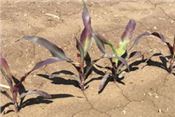|
Avoid Fallow Syndrome With A Cover Crop In 2019

Phosphorus deficient Corn plants – a typical symptom associated with corn grown following fallow.
GREGORY A. LUCE
COLUMBIA, MO.
There are many excellent reasons for planting cover crops, including, but not limited to: protecting the soil from erosion from rain and runoff, adding organic matter to the soil and suppressing weeds. With the prevented planting and flooding this season, another reason for planting a cover crop is to help prevent fallow syndrome in next year's crop. Fallow Syndrome is a result of population reduction of a particular mycorrhizal fungi (vesicular arbuscular mycorrhizae or VAM) due to no plants growing in that field the previous year. The mycorrhizal fungi has a symbiotic relationship with corn and small grains. The mycorrhizae develop around the corn roots and assist the root in taking up nutrients, primarily P and Zn. The mycorrhizae benefit by acquiring sugars from the root system of the host plant. Corn plants after fallow most typically show phosphorus deficient symptoms and growth can also be stunted. Many corn fields in 2016 experienced fallow syndrome symptoms following the prevented plant acres of 2015.
Most agricultural crops have a mycorrhizae relationship, and so do most weeds, but not all benefit equally from the symbiosis, and not all are equally as good of a mycorrhizae host. For instance, the Brassica family including forage radish and turnips, are not a host. Corn happens to be particularly dependent on mycorrhizae. So corn grown next year could be negatively impacted if no crops or weeds are growing in the field. Counting on weeds is not advised. Therefore, planting a cover crop on preventing plant ground is advised. Most species that may be considered for cover crops in 2019, such as cereal grains, clovers, sorghum, corn and soybean would provide mycorrhizae for next year.
Some research on Fallow Syndrome has shown that fallow has a greater negative impact on corn grown in lower P testing soils. Dr. Manjula Nathan, Director of the University of Missouri Soil Testing and Plant Diagnostic Service Laboratories, did her Ph.D. work in South Dakota studying: the Effects of Mycorrhizal Colonization, Early Growth and Phosphorus Uptake of Corn. Her work, in a two year study, showed that fallow negatively impacted phosphorus uptake of corn and also showed reduced corn growth in a low Phosphorus test soil. However, on a high phosphorus testing soil the fallow did not have those negative effects.
What to do?
If no crop was planted in 2019 consider planting a cover crop yet this year for providing a host crop for the mycorrhizae. Grasses like cereal rye, wheat or oats would be good choices, as would legumes like clovers or soybean. Remem¬ber that Brassicas, like turnip and radish, are not hosts to mycorrhizae and if used after fallow they would need to be mixed with host type cover crops.
• Establish a cover crop yet this summer/fall, as early as feasible.
• Don't skimp on phosphorus after fallow. If soil test levels are low a banded starter application for corn of Phosphorus and Zinc would be more effective than broadcast applications.
• Soybeans, planted next year after prevent plant acres, are not as susceptible to Fallow Syndrome as corn. However, managing a cover crop ahead of soybean is easier than before corn and cover crops provide many benefits.
• Typically the effects of Fallow Syndrome are not seen two years after the fallow period.
It is acknowledged that many growers are reluctant to plant a cover crop ahead of corn. If a cereal cover crop, like cereal rye or wheat is used before corn, then very early termination next year is advised. Spring oats planted in the summer/fall would provide a strictly winter-kill option. Another choice would be a combination of oats and crimson clover, with the clover providing some living roots through spring without creating any significant issues ahead of corn planting.
We continue to study the benefits and management considerations of cover crops across Missouri in the MU Certified Strip Trial Program and other research studies within MU Extension. Your local Extension Agronomist is an excellent resource for agronomic advice. ∆
GREGORY A. LUCE: Adjunct Instructor, Division of Plant Sciences, University of Missouri
|
|